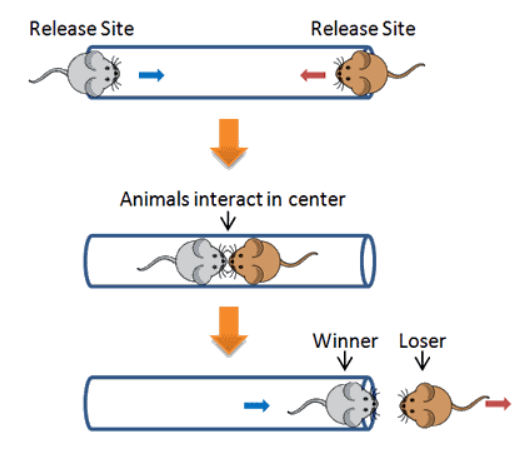How Your Place in the Social Hierarchy Can Protect (or Sabotage) Your Brain Against Addiction
- Lidi Garcia
- May 22
- 4 min read

People in lower social positions are at greater risk of developing drug addiction, and this may be linked to brain function. In rats, dominant individuals were more resistant to methamphetamine because they had a more active area of the brain that helps with control and decision-making. Subordinate individuals, on the other hand, had greater activity in the region linked to reward, which made them more vulnerable. Raising social status changed the brains of subordinates and reduced their search for the drug. In females, social position did not have the same protective effect.
Social status, that is, the position an individual occupies in a social group, can influence mental health and the tendency to drug addiction. Studies have shown that people in situations of lower social status face more stress and are at greater risk of developing mental disorders or engaging in substance abuse.
However, the biological mechanisms that explain this relationship are still poorly understood. This study investigated exactly this, using a model with rats to understand how social position affects brain function and behavior linked to addiction.

Researchers from the Chinese Academy of Sciences in China observed male rats and used a simple test called the “tube test” to determine which rat was dominant (i.e., the one that usually “wins” and has more control) and which was subordinate (the one that tends to “lose” and occupy a lower position in the group).
This study investigated how social status affects the risk of addiction to methamphetamine (METH), a highly addictive drug. In societies, both human and in animals such as rats, there are relationships of dominance and submission, that is, some individuals become “leaders” and others are in “subordinate” positions.
The scientists wanted to understand how these social differences influence drug-related behavior.

Dominance Tube Test
To do this, they used behavioral testing on male rats to determine which were dominant and which were subordinate. They then introduced methamphetamine as part of the experiment, observing which rats sought the drug more in a controlled laboratory environment.
What they found was striking. Dominant rats had more activity in an area of the brain called the mesocortical dopamine pathway, which is linked to control, judgment, and decision-making. These rats showed less interest in seeking the drug.
Subordinate rats, on the other hand, showed more activity in the mesolimbic dopamine pathway, which is associated with immediate reward and pleasure. They sought the meth more, indicating greater vulnerability to addiction.

To better understand these differences, the scientists used a technique called optogenetics, which allows the activity of specific brain circuits to be controlled with light. When they artificially activated the mesocortical pathway in subordinate rats, these animals began to behave more dominantly and, at the same time, their interest in the drug decreased.
On the other hand, when this pathway was “turned off” in dominant rats, they began to seek out methamphetamine more. This suggests that this part of the brain plays a direct role in both social status and resistance to addiction.
In addition, the researchers tested whether it was possible to change the social status of subordinate rats. To do this, they placed these animals in situations in which they repeatedly “won,” which increased their social standing.
Over time, their brains adapted, strengthening the mesocortical pathway and reducing drug-seeking behavior. This shows that social status is not just an external issue, but can actually reshape brain function and profoundly influence behavior.

Finally, the study also examined the behavior of females. Unlike males, females were equally vulnerable to methamphetamine, regardless of social status.
The pattern of activity in their brain pathways was more similar to that of subordinate males, suggesting that protective mechanisms linked to status may work differently between the sexes.
In short, this study helps to understand how social status directly influences the brain and the risk of developing drug addiction. It shows that individuals with higher status have a brain “shield” against addiction, while those in lower positions are more vulnerable, and that this can, to some extent, be reversed.
These findings have important implications for public policy, drug use prevention, and treatments, considering social and biological factors together.
READ MORE:
Social rank modulates methamphetamine-seeking in dominant and subordinate male rodents via distinct dopaminergic pathways
Xiaofei Deng, Wei Xu, Yutong Liu, Haiyang Jing, Jiafeng Zhong, Kaige Sun, Ruiyi Zhou, Liang Xu, Xiaocong Wu, Baofang Zhang, Wanqi Chen, Shaolei Jiang, Gaowei Chen, and Yingjie Zhu
Nature Neuroscience (2025)
Abstract:
Social status has a profound impact on mental health and propensity towards drug addiction. However, the neural mechanisms underlying the effects of social rank on drug-seeking behavior remain unclear. Here we found that dominant male rodents (based on the tube test) had denser mesocortical dopaminergic projections and were more resistant to methamphetamine (METH)-seeking, whereas subordinates had heightened dopaminergic function in the mesolimbic pathway and were more vulnerable to METH seeking. Optogenetic activation of the mesocortical dopaminergic pathway promoted winning and suppressed METH seeking in subordinates, whereas lesions of the mesocortical pathway increased METH seeking in dominants. Elevation of social rank with forced win training in subordinates led to remodeling of the dopaminergic system and prevented METH-seeking behavior. In females, however, both ranks were susceptible to METH seeking, with mesocorticolimbic pathways comparable to those in subordinate males. These results provide a framework for understanding the neural basis of the impact of social status on drug-seeking.



Comments